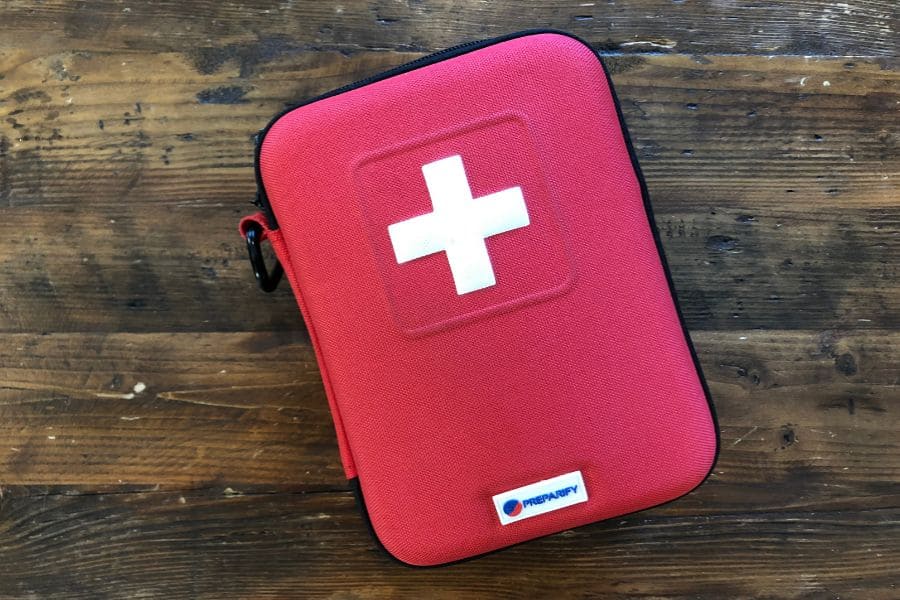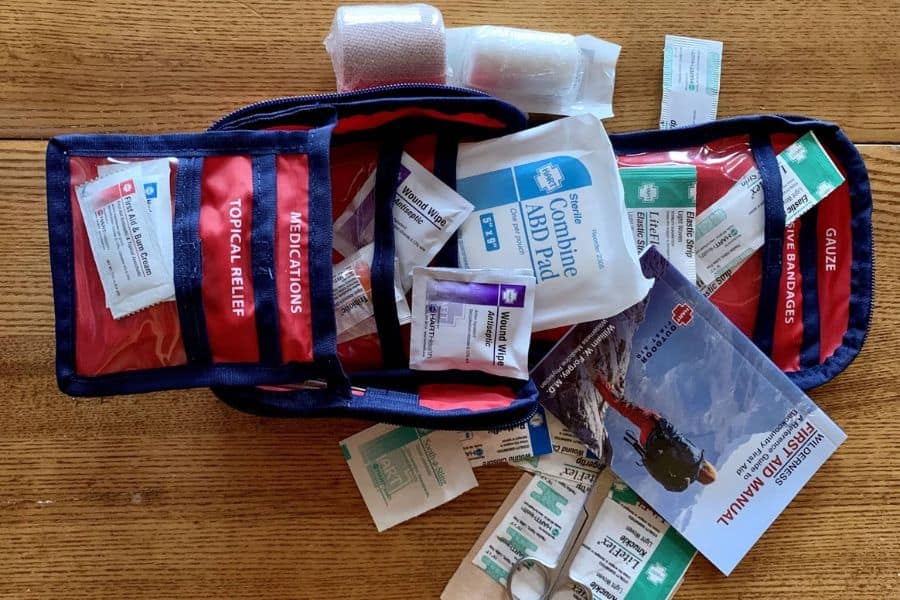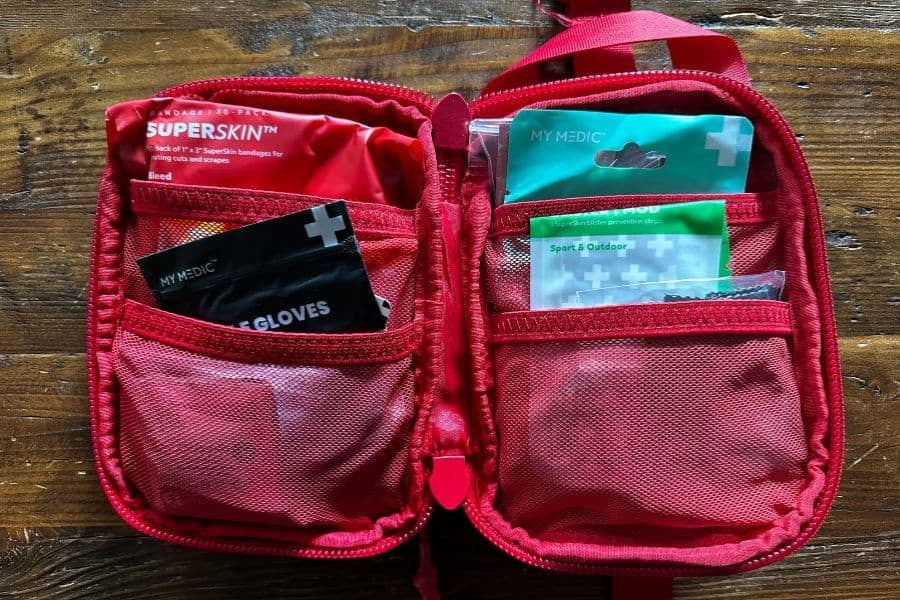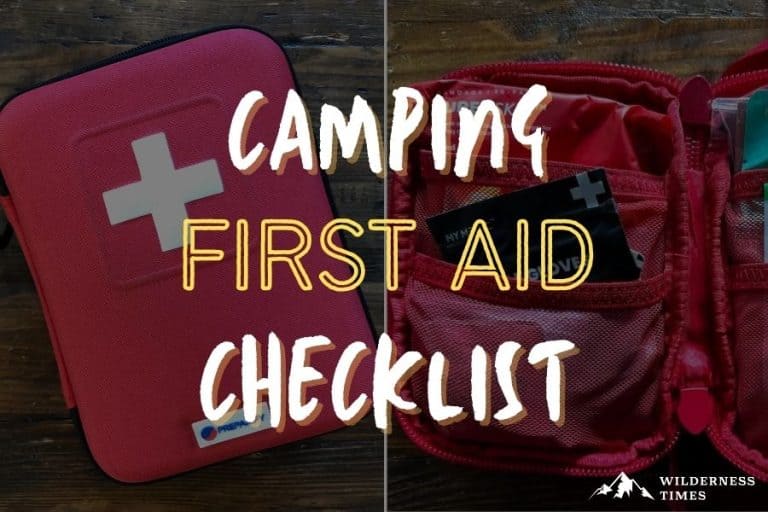As much as I love the outdoors, I have to admit – it can be dangerous.
Between animal encounters, trips & slips, and physical exhaustion… there’s a lot that could go wrong.
For emergencies, it’s wise to bring some first aid supplies with you. Even if you’re just going out for a day-hike, packing a first aid kit is a low-cost way to keep you safe.
As one of the ten essentials, first aid is a necessary component of your loadout. So, in this article, I’ll explain what to pack as well as how to keep your first aid kit in tip-top shape. Let’s go!
Before You Buy
There are a few factors to consider when choosing or designing a first aid kit. Here are some of the variables involved that can dictate what specific gear to bring.
Number Of Campers
First and foremost, the most important thing to consider is how many campers are coming with you.
When there are more hikers, the odds of injury increase. Each person that joins your party adds another two ankles that could get sprained on your trip.
More people means more supplies. Simple.
Also See: Hiking Injuries (Common Hiking Injuries and How to Treat Them)
Type of Campers
Also, consider who’s coming with you on your trip. Kids and adults have different needs, as do the young vs. old. Take this into account when looking at gear.
For example, kids are more susceptible to sickness. In the case of families, you might want to bring more sickness tools. Something about adulthood makes your stomach more resilient to bugs.
A counterpoint is when I go hiking by myself, I mostly pack first aid for injuries. This helps me save on weight while still arming myself for emergencies.
Trip Duration
Another characteristic to consider is how long you’ll be camping. The longer the trip, the more gear you’ll want to bring since there’ll be a higher chance for injury.
When I say duration, I mean both the trip time and distance. Quick, 2-mile day hikes don’t require much first aid. But, long, 3-week thru-hikes spanning tons of miles carry much more risk. Take trip distance and time when packing your first aid kit.
Trip Type
For example, I live in Colorado. There aren’t many mosquitoes up here, so I’m not really worried about allergic reactions.
But, if I was hiking on the East Coast or in the South, I would be much more concerned about bugs. So, I’d consider bringing an epi-pen in case of bee stings.
However, up here, I might want to bring some more gear for the cold. An emergency bivvy or some hand warmers might be useful here, whereas they’ll be worthless in Hawaii.
Personal & Prescription Pills
Last but not least, remember to bring any prescriptions that you may require. I don’t know what you take (that’s up to you) but pack these as well.
Remember, you might get stuck in the woods longer than you plan. So, bring some extra pills to keep you going.
Camping First Aid Checklist
Now that you know how to decide what to bring, here are some straightforward checklists for you to use.
Basic Kit

Here’s a brief list of what should be in your most basic first aid kit.
This is a solid load-out for day hikes, first-time hikers (who need beginner advice), or brief overnight stays.
- Band-aids – various sizes
- Gauze pads
- Antiseptic wipes (alcohol)
- Antibacterial ointment (Neosporin)
- Ibuprofen or aspirin
- Antihistamine (Claritin)
- Tweezers (disposable)
- Medical tape
- Blister treatment
- Hand sanitizer
That gear should be affordable and accessible enough for most trips.
Specific Treatments

Here are some first aid supplies that are more specific. They might not be necessary for all people or adventures, so take a look and make your own call.
- Sunburn relief spray
- Cough drops
- Eye drops (Rohto)
- Antacid (Tums)
- Glucose (for hypoglycemia)
- Epinephrine (epi-pen, for allergic reactions)
Most of these can be found around your house. Or, you can find travel size treatments at your local pharmacy or on Amazon.
Serious Supplies
On most trips, the worst you’ll get is a cut or bug bite. But, some trips might cause some severe damage to your body. For longer trips, it might be worthwhile bringing some more hospital-grade supplies with you.
Pack these at your own precaution. If you’re just taking a day trip, these are probably unnecessary.
- Knife or multi-tool
- Tourniquet
- Thermometer
- Hospital shears
- Surgical gloves
- CPR mask
- Compression wrap (sprained ankle)
As mentioned, make sure you know how to use this gear before hitting the trail. You don’t want to be reading the instructions while someone is wrestling with severe pain.
How To Properly Pack A First Aid Kit

Now that you know what to bring, how do you pack it together?
You might think that you can just throw your supplies in your backpack and call it a day. Wrong!
This is a recipe for disaster and an easy way for you to misplace your gear. Here’s how to pack a kit using the Wilderness Times method.
Use Ziploc Bags
To prevent damage to your first aid gear, I recommend using Ziploc bags. These bags will not only organize your supplies into neat categories, but they’ll also protect your stuff from cuts and tears.
If you can, splurge on freezer-style bags. These are much thicker than usual bags and will thus last longer.
Speaking of longevity, label your bags using a Sharpie or another permanent marker. Pen (and definitely pencil) will fade off your containers over time. The turbulence of hiking could wipe your writing right off. Instead, use a permanent marker to write labels that’ll last for years.
While organizing your gear, keep them in separate bags according to their category. An excellent way to do this is to have bags for wounds, medications, and sickness. This is an easy way to speed up the first aid process in case of an emergency.
Expiration Dates
Word of caution. Believe it or not, first aid kits are not non-perishable. That means they expire.
Although some items like band-aids, nitrile gloves, and gauze never go kick the bucket, other things might. Medications like aspirin and acetaminophen do expire and have consequences if consumed after expiration.
Most first aid items and kits will last 3-5 years. But, time flies, especially if your first aid kit doesn’t see much use.
I recommend checking your first aid kit once a year. This is an effortless technique for making sure nothing is expired. Put a reminder on your calendar or just do this check before your next big trip. In most cases, you’ll be fine.
While you’re checking expiration dates, check your first aid inventory as well. Make sure everything is stocked, and nothing is torn or broken.
Pre-Packaged Kits
The last thing we’ll discuss is using a pre-packaged first aid kit.
In today’s instant gratification society, everyone wants things NOW. We want faster internet, faster results, and quicker Amazon Prime delivery.
Well, I’m here to tell you some great news. You can skip all of the first aid planning by buying a pre-packaged first aid kit.
There’s no shame in buying one off the rack. In most cases, these kits are actually a better choice than building your own. Purchasing a pack from the store guarantees that you get everything you need, packed and organized in a convenient, easy-to-use bag.
Down the road, you might want to upgrade your equipment. But, most hikers and campers can do just fine with pre-packed first aid kits.
I really like REI’s first aid kits. The package lists how many people it’s suitable for, as well as how long of a trip they’ll cover. This is a convenient way to make sure you’re prepared for your hike.
For example, this half-tin is suitable for 1-2 people for a day hike. I love the tin as well, it packs well and won’t get punctured.
If that’s too small, this affordable hiker kit works for 2 people for 2 days. That’s enough gear to cover 99% of hikers.
How To Use A First Aid Kit
Even if you pack all the first aid gear in the universe, that gear is useless if you’re not trained on how to use them.
Once you assemble your first aid kit, have a look through and make sure you know how to use everything. If you’re confused, read the directions. It’s usually more straightforward then you’d expect.
By familiarizing yourself with your first aid kit, you’ll be that much more prepared for when injuries happen in the woods.
A good example is a tourniquet. A tourniquet, for the uninitiated, is a tool used to apply pressure to a limb to prevent bleeding. This tool can be tricky to use, especially if your brain is thrust into a “fight or flight” situation.
To learn how to use this tool, here are some step-by-step guidelines.
For every other tool, here’s a comprehensive video that breaks down how and when to use your first aid kit:
First Aid Courses
If you want to take your first aid skills to the next level, consider taking a first aid course.
First aid courses vary in their content and coverage. Before going to a class, try to see what the curriculum is so you can see what you’re learning.
A great skill to learn is CPR. If you’re in the middle of the woods, the last thing you want to do is choke on a piece of beef jerky. CPR requires little to no equipment, so it can be handy on the trail.
Check out your local community center for when they’re available. Or, the Red Cross offers courses nationwide, so anyone can learn how to save a life.
Conclusion
To wrap things up (like an ankle sprain, get it?), pack a first aid kit.
The items above can be purchased for less than $20, and that’s including a fancy first-aid carrying case.
These tools are lightweight and easy to use. Although simple, they could possibly save you or your loved one’s life one day.
Don’t think you’re “too cool” for a first aid kit. You’ll get injured eventually, and you’ll be super thankful that you packed this gear.


